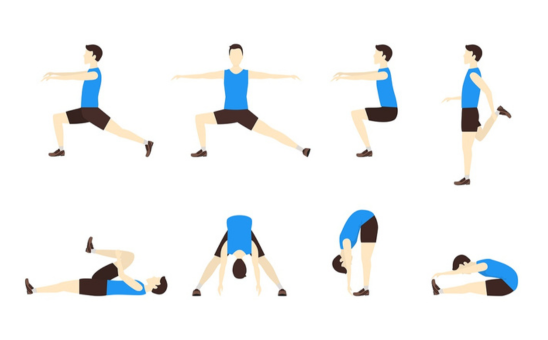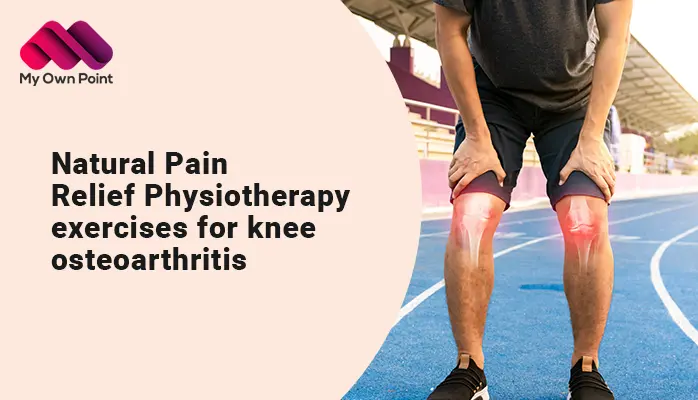Introduction
What happens if your muscles become stiff during exercise repetitions? Obviously, it may become more difficult for you to fully stretch and contract your muscles, leading to a less toned physique. There is no evidence stretching after exercise stops muscles from growing, but if you don’t pull properly, you risk injuring your muscles or making them tired.
If your muscles aren’t working at their best, reaching your fitness goals might be tough. It could make it hard to stretch and contract your muscles fully, leaving you with a body that’s not as toned as you want. But don’t worry! We have a great solution for you – 7 stretching exercises between your workouts.
To avoid this, you should stretch before and after you exercise. So, get ready to know some stretches to relieve muscle tension and anxiety.
What Causes Extremely Tight Muscles?
Nowadays, people frequently encounter discomfort like neck and lower back pain after spending extended periods seated. The concerning issue arises when individuals with desk jobs must lean their heads forward for prolonged periods, leading to potential cervical pain.
- Awkward positions, intense exercise, and prolonged sitting can lead to sore and tight muscles.
- It is commonly caused by overuse of skeletal muscles and lack of movement.
- Temporary damage to muscle cells can result in stiffness.
Does Stretching Relieve Muscle Tension?
Yoga, workouts or stretches to relieve muscle tension can be an incredible blend of dynamic ways and the ultimate weapon. It activates your range of motion and ignites concentrated blood and oxygen circulation, delivering essential nutrients to your tissues.
Ensure you obtain ample rest, consume abundant liquids, and refrain from exerting excessive strain on the affected muscle. Utilising heat pads or ice packs on the power can promptly alleviate discomfort.
Don’t worry; we have a fantastic trick that can assist you—introducing 6 yoga-inspired stretching exercises that you can incorporate between reps. Trust us, these stretches to relieve muscle tension will effectively alleviate and help you achieve your fitness routine goals.
Best Type of Stretches to Relieve Muscle Tension
Stretching is an integral part of your workout routine. It helps to relieve muscle tightness, eliminates lactic acid and aids in the cooling down process. But with busy schedules, it’s easy to forget to stretch. These 6 stretches are quick, easy and practical to add to your post-workout routine.
1. Arm Stretch
While it may seem like a stretch reserved for your yoga class, this simple wrist and finger stretch can help prevent wrist pain in addition to helping you recover from a workout. This type of stretching increases the overall flexibility of your wrists, fingers, and forearms. It can also mitigate conditions such as carpal tunnel syndrome, ulnar deviate, and sprains or tendonitis of the muscles that flex or extend your fingers.
- Stand straight with relaxed arms.
- Hold your right arm out in front of you at shoulder height.
- Bend your wrist so your palm faces downward.
- Use your left hand to gently grasp your fingers and pull them back towards your body.
- Repeat with the other arm.
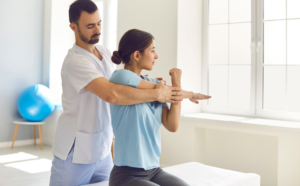
These Stretches include the seated biceps stretch and leaning bench triceps extensions to help your wrists and hands. It will ensure you cover all your bases regarding stretching and recovery.
2. Calf Stretch
These muscles are essential for walking and running, but tightness can cause injuries like shin splints and Achilles tendonitis. You can do calf stretches before or after a workout, yoga, cardio, or any other wellness activity. Daily stretches to relieve muscle tension is responsible improves blood flow and makes you more flexible.
There are many calf stretches, but the most common is the “runner’s stretch.” This exercise requires no equipment and provides a stable, safe stretch without stressing the ankles or feet. It also allows you to monitor the intensity of the period, pushing as little or as complex as needed.
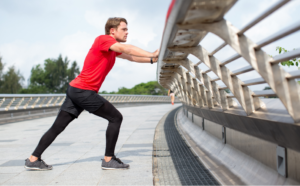
Note: Try this stretches to relieve muscle tension several times a day or as your physical therapist recommends.
3. Side Stretch
This stretching exercise helps to alleviate back pain and improves strength, stability, and flexibility. The overhead side reach stretch is simple but powerful for the entire upper body, including the shoulders and neck
- Stand with one foot in front of the other and hands on hips – Lift left arm overhead and lean to the right
- Feel a comfortable stretch in shoulder and neck
- Avoid pushing the stretch too far to prevent strain or pain
- If unable to raise arm overhead, try the half-hero variation of the side stretch
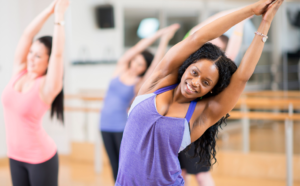
This variation is easier because you can support yourself with the bent knee leg instead of bending away from it. It also targets the tight hip flexor on the trailing portion, which is common for people who work at desks for long periods.
4. Shoulder Stretch
This shoulder stretches to relieve muscle tension helps to release the tightness in your chest muscles and front of your shoulders. Gently swing that arm in circles—forward, backward, side-to-side, up, then down—for 30 seconds to two minutes.
- Stand with your back against a wall.
- Place palms on the door frame or wall.
- Walk arms up the wall slowly.
- Feel a stretch in your shoulders.
- Loosen shoulders by rolling them up and down in a seated position.
- Repeat 10 times.
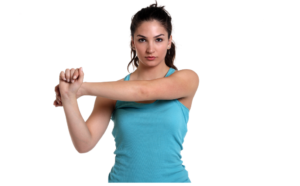
Another shoulder stretch, the pectoralis external rotation, can help relieve pain caused by rounded shoulders due to sitting too much.
5. Wrist Stretch
Whether from work, repetitive motions at home or the gym, wrist pain is common and can significantly limit your activity level. Stretching your wrists, fingers, and forearms can help prevent injury and increase your mobility.
- Begin by resting your wrist on a flat surface, such as a table.
- Then splay your fingers wide,
- Create a fist and squeeze for one to two seconds.
- Exercise stimulates wrist and hand muscles, improving blood flow
- Stretching forearms helps with wrist movement.
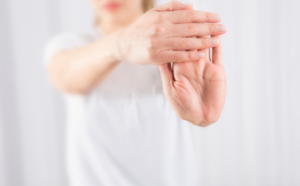
Performing these simple stretches after a workout can help prevent wrist injuries. However, it’s important to always check with your doctor to ensure these stretches to relieve muscle tension are safe for you.
6. Leg Stretch
Stretching muscles that are a bit tight is a good idea after a workout. But stretching to the point of pain is not recommended, and can cause injury. This is especially true if you are not careful and use jerky movements. A gentle stretching approach is usually better, such as the leg stretch shown here.
- Stand at arm’s length from wall.
- Place right hand on wall for support
- Bend left knee and grab left ankle with left hand
- Pull foot towards butt until feeling a light stretch in front of left leg
- Hold for 30 seconds
- Repeat on other side
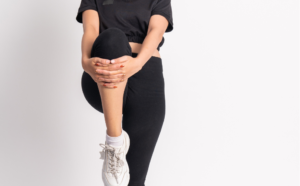
This leg stretch is intended to loosen the hamstring muscles along the back of the upper leg and the Achilles tendon in the lower leg. It also works the hip flexors and quads, which are used when walking or running.
7- Lying Glute Stretch
If you’ve been sedentary for a while, this stretches to relieve muscle tension is perfect for adding mobility to your lower back. Remember, even a short pause can alleviate stress, as stated by Decker. Also, this stretch loosens tight hamstrings and targets the lower back by externally rotating the hip and stretching the outer glutes.
- Lie on your back and bend knees, feet flat on floor
- Cross right foot to left knee, creating a figure four shape
- Bring hands behind right knee and pull legs towards chest
- Repeat on other side
- Use towel if needed to help pull leg forward if unable to reach knee
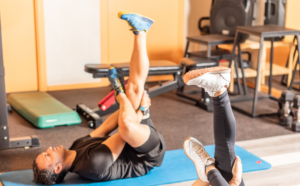
FAQ:
1- Question: How do you stretch tight muscles?
Answer: Make sure to stretch carefully and slowly without pushing your body into painful positions. So, Stretches to Relieve Muscle Tension is a great way.
2- Question: Does stretching reduce muscle tension?
Answer: Stretching helps to ease muscle tension, which can reduce pain. It also boosts levels of serotonin, a hormone that improves mood and lowers stress, leading to less depression and anxiety.
3- Question: What type of stretching is best after a workout?
Answer: Experts suggest doing moving stretches before exercising and still stretches after exercising.
4- Question: Can I stretch immediately after a workout?
Answer: Stretch after warming up or exercising for the best results. Warm muscles stretch better, improving your flexibility. Plus, you’re less likely to injure a friendly, flexible power.
5- Question: What happens when you dont stretch after exercise?
Answer: Stretches to relieve muscle tension is not just for flexibility but also muscle growth. It’s very effective. If you don’t try, you might unknowingly reduce your muscle growth. Quick Stretches for Stress Relief

